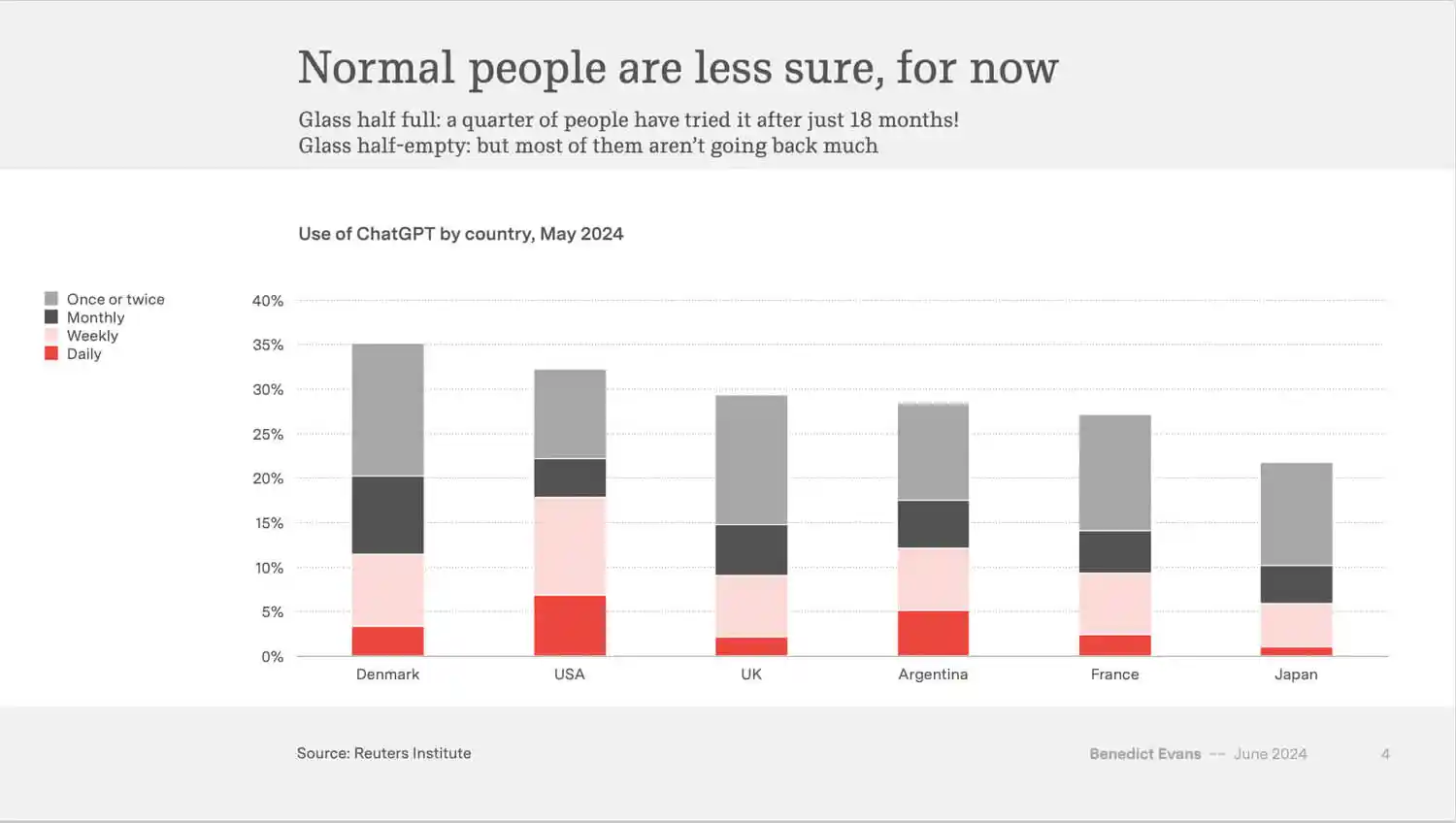
I. Apple's Generative AI Strategy and Characteristics
A. Generative AI Perspective
Apple has a unique view on generative AI, considering it a technology rather than a product, which differs from the "AI Maximalist" perspective. The "AI Maximalist" believes that general-purpose chatbots can replace much of the software, while Apple embeds it into the system and breaks it down into individual functions to run efficiently on small devices.
B. Foundational Model Building
Apple has built its own foundational models, whose performance is comparable to other products on the market in the benchmark tests released, but without a chatbot interface. Users cannot directly input raw prompts to get raw outputs; instead, they are guided through various buttons and options, with different functions presented in different ways. For example, email priority settings, document summarization, and other features do not have an obvious chatbot presence. Siri also uses these models, but returns graphical user interfaces (GUIs), with foundational models abstracted into API calls.
C. Distinguishing "Contextual Models" and "World Models"
Apple differentiates between these two types of models. "Contextual models" can access all contextual information of the user on the phone, such as emails, location, etc., which are private both on the device and in Apple's "private cloud," and are used to drive related functions. For questions unrelated to the user's context, such as giving suggestions based on shopping photos, third-party "world models" (such as ChatGPT) are used, which have open prompts and give raw outputs but do not have user contextual information.
II. Comparison of Apple with Other Companies in the Field of Generative AI
A. Comparison with Cloud Models like OpenAI
Contextual Advantage: Cloud models from OpenAI and other new companies do not have access to information related to users' mobile phones. Google has world models, and some Android users have partial context, but Android users are a minority in the United States, and the proportion that can run related functions locally is even lower. Microsoft's AI PCs have some work-related context, but smartphones are the primary device for most people and have more real context. Meta may have some context, which could trigger antitrust discussions in the future.
Model Replaceability: Apple's foundational models are not the best in all aspects, but they are good enough for the functions they provide. Google's memos once claimed that LLMs have no moat, and now there are indeed many excellent models. OpenAI is leading but not significantly ahead. Apple treats OpenAI as an interchangeable plugin, allowing it to bear the inference cost in exchange for the opportunity to promote premium subscriptions to Apple users, similar to Google paying Apple $20 billion a year to become the default search engine.
B. Comparison with Integration of Own Products
Apple is somewhat similar to Meta in that it places some computing on the user's terminal devices, reducing costs and making Apple's intelligence free. This contrasts with NVIDIA's chip sales and cloud service providers' data center investments because the global smartphone and PC market is huge, and users pay for devices, so there is motivation to put more functions on the devices. At the same time, Apple is also similar to integrating some technologies into the system, such as spell check moving from a separate product to a system function, and generative AI functions may also gradually be integrated into the system.
C. Impact on NVIDIA
Apple is strong enough to go its own way, controlling software and APIs, having a world-class chip team, and being able to prioritize TSMC resources. It is not clear what the impact on NVIDIA will be, but Apple's strategy may shift more inference to edge devices because as actual use cases break down models into functions, foundational models are not entirely suitable for mobile phones, but inference can be more quickly shifted to the edge.
III. Development Prospects and Challenges of Apple's Generative AI
A. Large-scale Application and Challenges Yet to Be Faced
Apple's generative AI features will be launched in stages in the fall, and initially, they will only be available to some iPhone 15 Pro users, with most iPhone users unable to use them. There may also be developer incentive issues, and the actual effect may not be as good as the demonstration.
B. Product and Market Fit
Although half the population in many developed countries has tried generative AI, only half of them use it again, indicating that the product and market fit is not yet achieved. Generative AI is still developing rapidly, and new breakthroughs may change use cases. Currently, Apple's strategy is to use it as a unified contextual model on mobile phones to drive functions, rather than adding unrelated LLM functions throughout the company, but it remains to be seen whether it can successfully integrate new technology as a product feature.
C. Possible Future Development Directions
Apple may further shift more use cases from third-party models to its own models and may also consider letting Bing and Google compete for the default position. At the same time, as technology develops, models will become larger and more efficient, edge devices will become faster, and there is still a lot of uncertainty about future development.

